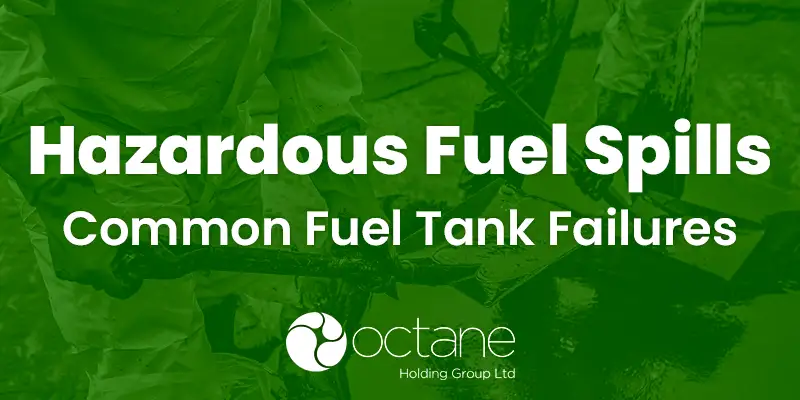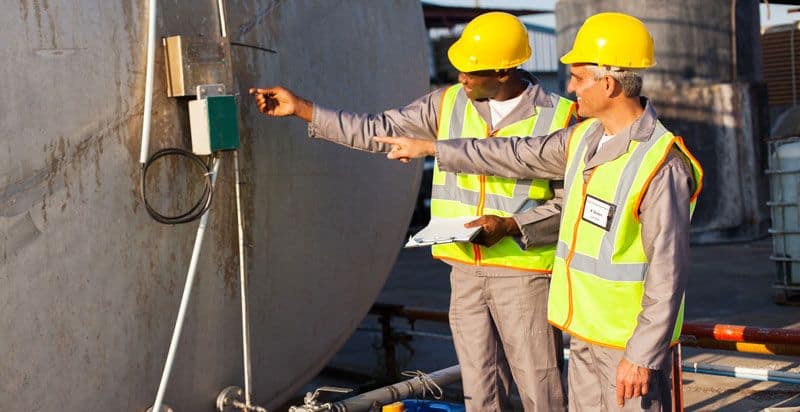Latest News
Keep up to date with latest news and insights from Octane Holdings

The Top 6 Causes of Hazardous Fuel Tank Spills
In this article I want to discuss some of the most common causes of above ground fuel tank spills and how you can avoid them. (Hint: it’s most often not the fault of the tank, but human error at the root cause of most spills.)
How can such spills be avoided? What lessons can be learned from past errors that have led to fuel spills?
I know from years of experience in the fuel storage industry that companies choose above ground fuel tanks because it’s often a financially attractive choice, with significant savings to be made when compared with underground tanks.
The Environment Agency also tend to prefer above ground tanks because they can easily be inspected. That is not to say above ground tanks are without risk, and the consequences of a leak or catastrophic spill above ground can be as severe in comparison to an underground spill.
Below I outline the 6 major causes of fuel spills we most commonly see, with the aim of helping your business implement and maintain the best practices to avoid them happening on your site.
Fuel Tank failure
All of the stats tell me that above ground fuel tank failure is relatively uncommon, but it’s most likely to result in a catastrophic spill. Failure can be caused by a range of issues. Weakening welds on seams and corrosion of walls can contribute to so called pinhole leaks.

Total roof collapse of a tank is also a risk associated with corrosion of support beams due to a build-up of acids and salts. Extreme temperature variations can cause fuel loads to expand rapidly. If tanks are overfilled this can cause catastrophic breaches.
Tank failure can sometimes occur a long time after the cause was put in place. This relates to poor construction choices. Inadequate footings or an unsuitable location (unstable ground or in a high risk seismic area) can ‘build in’ a catastrophe years ahead of time.
Misuse of the tank by filling it with a liquid that is incompatible with the construction of the tank can also cause leaks.
Tanks can also fail due to an uncontrolled fuel ignition and explosion. The risk of this happening is very small but must be managed as the consequences can be enormous. (Think costs, bad PR environmental damage and potentially endangering life – not good at all!)
Related: Why you must legally inspect your above ground fuel tank annually
Overall, these risks can be easily mitigated with a carefully planned tank installation, regular inspections and tank maintenance, plus replacing your tank in a timely manner.
Piping failure
Openings of above ground fuel tanks can be vulnerable to spills in some situations. I am not at all surprised by the stat that up to 82% of leaks from fuel storage tanks involve faulty or improper use of pipework.

Special care and attention must be paid to equipment and procedures related to moving fuel, and securing these openings when not in use. Pipes, especially threads and fittings are vulnerable to corrosion.
The couplings are also susceptible to impact damage from being moved, thrown or even run over. If a coupling breaks or a pipe bursts then quick action will need to be taken to stem the leak.
Pipework can also contribute to leaks if valves and filters are not in working condition, or the pipe diameters are not adequate. If tanks are filled under pressure, further weakness can occur.
The location of pipework can also be a contributing factor.
If pipes are located so that they are exposed to very different temperatures to the tank (like cold underground pipes and warmer air temperature around the tank), the oil may experience rapid expansion or contraction, putting stress on weaker joins.
Furthermore if workers need to access the tanks, the location of pipes, valves and openings must be appropriately accessible in order to monitor fill alarms.
The solutions here again involve regular inspection and maintenance, coupled with proper procedures and training methods.
Poor maintenance
As you would probably have been expecting me to say at some point in this list, human error is a large contributor to tank leaks of all sizes. Poor maintenance can affect different areas of a tank, leading to substantial vulnerabilities.
For example, poor maintenance of meters led employees to disregard alarming pressure readings in the case of the infamous Bhopal disaster in 1984. The act of ignoring the meters was identified as one of the causes of the fatal gas leak.
Other common issues relate to failure to inspect and replace filters and seals. Lack of process or oversight can lead to important processes being forgotten or missed.

Often, simple acts like maintaining a clean worksite, or failing to replace a removed part or even close a valve can lead to significant leaks. It’s not just equipment based maintenance issues that must be kept to a high standard!
Flushing tanks and lines with water is a common practice. If it’s not completed accurately there are increased risks of corrosion, and uncontrolled expansion and contraction of water in extreme temperatures can cause unpredictable results.
Scheduling regular inspection and maintenance from industry accredited engineers is a basic requirement to prevent these issues.
Dispensing problems
Dispensing fuel from tanks can present higher risk situations. The risks can be mitigated but they need to be identified first. If the fuel is being dispensed in a professional setting, it’s likely that the risk of spillage is due to equipment failure or valves being unintentionally left open.
In customer/client facing situations it’s more likely to be user error due to unfamiliarity with the equipment or the risks.
Faulty lines and bowsers can leak. While this is not as dramatic as a spill, the consequences can still be damaging (to the environment, as a potential fire risk and also to the bottom line as the cost of wasted product). Related: Health and Safety Guidelines for Dispensing Fuel as an Employee
Following the above health and safety guidelines for dispensing fuel, and ensuring all staff are correctly trained to do so will significantly cut the risk of leaks during fuel dispensing.
Delivery problems
Another of the potential issues I’ve been aware of, is at the point of transfer of fuel between storage systems.
This process contains a risk of spillage. If the tank being filled is not bunded or does not have a berm of some kind surrounding it, any overfill errors will lead to uncontained spills.
Overfilling tanks is usually an error made by operators not paying attention or inexperience, so in my view it’s important that you try to work with established and experienced companies with a good reputation.
It could also be a situational risk, for example, if the operator cannot position themselves close enough to the onboarding tanks to observe fill alarms. There is also the potential for meters to fail or give false readings, leading to unintentional overfilling.
One solution could be during the planning and design of your fuel tank site prior to installation. Where possible ensure the tank is in an easily accessible area where delivery vehicles can park nearby and the operator can clearly see the tank.
Physical safety and security failures
It’s a sad fact that some people are motivated to seek out and damage above ground fuel storage tanks.
They may be motivated by political or environmental reasons. Some tanks are damaged through thoughtless acts of vandalism. Some are damaged accidentally, by car accidents or nearby construction, but this can be protected against by installing crash barriers.

Spills could also occur during acts of fuel theft, particularly when larger economic factors are at play, so it’s important to have tight security.
In these cases, the way to mitigate the risk is to protect the tanks as much as possible. In the example of intentional damage, this could mean providing secure fences or security patrols.
Installing locking mechanisms or other protections on bowsers may help to deter theft. To reduce the risk of accidental damage, tanks may need to be distanced from roadways, or strict speed limits put in place near the tanks.
Conclusion
From my own experience the consequences of spills and leaks from above ground fuel storage tanks cannot be understated.
The costs can extend not just to repairs, environmental restoration and compensation but to prosecution, fines and even prison time. Understanding what some of the causes of spills are can help to prevent them from happening.
All of the causes outlined above can be traced back to human error in one form or another. I think It is painfully clear that most spills can be avoided by implementing appropriate maintenance procedures.
Brand new installations should be conducted by qualified engineers and technicians who understand the needs of the company and future uses of the tanks.
Clear action checklists that outline what to do in the event of a spill will also help harm minimisation should the worst occur.
If you are unsure about the condition of your fuel tanks, please contact Octane today. We offer a range of services including our Site Audit & Risk Assessment (SARA), tank servicing and replacement.


